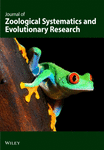Competitive selection in mono-, di- and tri-genotype cultures of Drosophila melanogaster
Abstract
Viability and larva-to-adult development of three strains of Drosophila melanogaster (one wild strain and two eye mutant strains: cardinal and sepia) were studied under three different situations: A. Monocultures of wild, cardinal and sepia respectively. B. Dicultures with the combinations wild/cardinal, wild/sepia and cardinal/sepia respectively. Seven points of different genetical composition were chosen for each of the three systems. C. Tricultures with wild/cardinal/sepia. Seventy composition points were chosen. The points arranged in a three dimensional diagram with the axes wild, cardinal and sepia, make up an equilateral triangle hyperplane.
An analysis of optimal density and intrinsic viability showed that sepia has a lower optimal density and higher mortality than wild and cardinal, whereas wild has a higher optimal density than cardinal, however its mortality is higher.
The response pattern of dicultures and tricultures is not fully predictable from the monocultures, since there is intergenotypic competition in di- and tricultures. However, it appears that wide differences among optimal densities and among intrinsic mortalities do not lead to stable equilibrium points.
For a treatment of the triculture responses the multivariate method of principal components was used. For the survival of tricultures the three dimensional space can be reduced to a plane with two principal components, which explain 99.75% of variance among output points.
Zusammenfassung
Konkurrenzselektion in Mono-, Di- and Tri-Genotypkulturen von Drosophila melanogaster
Die Viabilität and die Larven-Adult-Entwicklung wurden in drei Stämmen von Drosophila melanogaster (ein Wildstamm and die beiden Augenfarbenmutanten cardinal and sepia) bei drei verschiedenen Bedingungen untersucht:
A. Einfachkulturen von wild, cardinal oder sepia.
B. Zweifachkulturen mit den paarweisen Kombinationen wild/cardinal, wild/sepia oder cardinal/sepia. Hier wurden jeweils sieben verschiedene relative Zusammensetzungen getestet.
C. Dreifachkulturen mit wild/cardinal/sepia. Hier wurden 70 verschiedene Zusammensetzungen untersucht. Werden diese relativen Anteiligkeiten in einem dreidimensionalen Diagramm mit den Achsen wild, cardinal and sepia graphisch dargestellt, so liegen die Punkte in einem gleichseitigen Tetraeder.
Eine Analyse der Ergebnisse zeigt, daß die optimale Dichte für sepia niedriger liegt als für cardinal und wild, daß von allen Stämmen das höchste Dichteoptimum hat. Die spezifische Viabilität ist für sepia am niedrigsten, gefolgt von wild; cardinal hat die höchste Viabilität.
Das Reaktionsmuster der Zweifach- und Dreifachkulturen ist aus den Resultaten der Einfachkulturen nicht vollständig voraussagbar; es tritt spezifische Konkurrenz zwischen den Genotypen auf. Es dürfte sich auch wegen der sehr starken Unterschiede in der optimalen Dichte and der spezifischen Mortalität keine stabile Gleichgewichtssituation ergeben.
Für die Behandlung der Resultate aus den Dreifachkulturen wurde eine Multivariat-Analyse angewendet. Für die Viabilitäten kann der dreidimensionale Raum auf die Ebene der Hauptkomponenten reduziert werden, die 99,75% der Varianz unter den gefundenen Punkten erfaßt.




